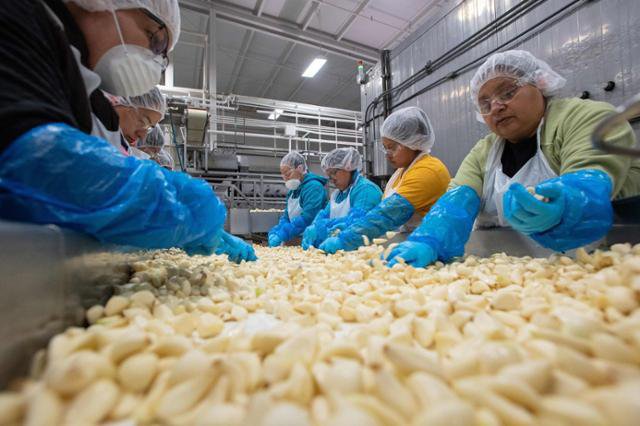
By Lucy Craymer
Feb. 20, 2020
Garlic prices are rising. The reason: the widening coronavirus outbreak is causing disruptions in the supply chain in China, the world's largest producer of the vegetable.
In recent years, China has been responsible for as much as 80% of the global garlic supply. More than two-thirds of the fresh garlic that the U.S. imports comes from China, according to the United Nations' Comtrade database.
U.S. retail prices of garlic are now at their highest levels since 2018, driven by concerns that supplies could run short in the coming months. A sleeve of garlic—which typically contains five bulbs—cost an average of $1.425 in stores during the first two weeks of February, up 29% from a year earlier, according to the U.S. Department of Agriculture.
Wholesale prices have jumped even more. A 30-pound bag of white Chinese garlic imported into California recently sold for $85 to $87, up 60% since the start of the year, USDA data showed. In contrast, prices for other agricultural commodities—like soybeans and cotton—have fallen because of expectations for lower Chinese demand.

josh edelson/Agence France-Presse/Getty Images
Garlic production in China has slowed since authorities sounded alarms over the spread of a new pneumonia-causing virus just before the start of the Lunar New Year holiday in late January. The Chinese government extended its national holiday into February to discourage people from traveling long distances and coming into contact with infected people. Thus far, more than 74,000 people in China have contracted the respiratory virus, now known as Covid-19, which has caused more than 2,000 deaths.
Many transportation and shipping routes have been hindered by lockdowns in cities affected by the outbreak, in addition to quarantine measures in other areas. Farms and logistics companies are also facing labor shortages because millions of workers have yet to return to their jobs after the holiday, according to agricultural analysts.
It usually takes about nine months to grow garlic before it can be harvested, which typically happens once a year during the summer. The bulbs are then sold over the following year. A lot of the garlic is also chopped up, peeled or processed into dry flakes before it is sold.
China produced about 49 billion pounds of garlic in 2018, which is the most recent annual data available. Most of it was for domestic consumption, according to the United Nations Food and Agriculture Organization.
America imported 199 million fresh pounds of garlic that year. Of that, about 70% was sourced from China, according to U.N. Comtrade data.
The average American consumes about 2 pounds of garlic a year, according to a Michigan State University report. Garlic's flavor has been gaining popularity in the U.S., and it is commonly used in ethnic cuisines from Asia to the Mediterranean. Some people are also adding more garlic to their diets because they believing it has many health benefits.
Christopher Ranch, one of America's largest garlic producers and suppliers, grows about 100 million pounds of garlic a year on its farms in California. It also buys garlic from China and other countries and sells it under a different label.
The Gilroy, Calif.-based company has reached out to growers in Argentina, Mexico and Spain to source more garlic in light of the recent China price surge, said Ken Christopher, executive vice president and grandson of the farm's founder.
"It's hard to come by and…it's incredibly expensive," he said of Chinese garlic right now. In China, wholesale garlic prices rose 13% in the first two weeks of February versus the average price in January, according to government data.
Over the past year, American garlic farmers benefited from the U.S.-China trade war, especially after the U.S. increased the tariff on Chinese garlic to 25%.
Because the latter is cheaper to produce—due to low labor costs and fewer government regulations—American farmers historically had difficulty competing on prices with Chinese garlic sellers.
John Milan, who owns five U.S. farms that grow elephant garlic—a large variety that has a milder flavor—said tariffs helped buoy the prices of homegrown garlic. He expects prices to climb further this summer when he sells his next batch of crops.
The U.S. currently consumes more garlic than it produces—a result of a drop in the number of domestic garlic farms over the last few decades. Mr. Milan said all the garlic from his farms was sold within three months last year.
According to local media reports, Chinese citizens have been eating more garlic cloves during the coronavirus outbreak because they believe its medicinal and antibacterial properties could help prevent them from getting sick.
In 2003, during the outbreak of severe acute respiratory syndrome, similar supply bottlenecks and demand surges drove prices of garlic and garlic products higher world-wide.
A major outbreak of swine flu in China in 2009 also saw garlic prices surging in the country, though some believe that was largely driven by speculators and a supply shortage.
The World Health Organization says that while garlic is a healthy food that may have some antimicrobial properties, there is no evidence from the current outbreak that eating garlic has protected people from the virus.
Write to Lucy Craymer at Lucy.Craymer@wsj.com
Copyright 2020 Dow Jones & Company, Inc. All Rights Reserved.



